The Governor
Lachlan Macquarie 1810 to 1821
review by Alan Atkinson
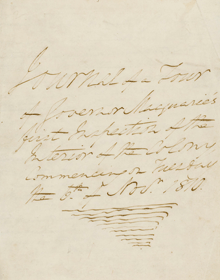
Detail from Governor Macquarie's journal, 1810
State Library of New South Wales
Lachlan Macquarie is God's gift to museum curators. His achievements while he was Governor of New South Wales (1810–21) have a type of grandeur, an aesthetic and spatial dimension that is enormously appealing. So much of what he did is collectable. He was also a self-conscious nation-builder, with a Keatingite feel for 'the big picture', and that makes him easy to fit into the narrative of national identity. The superabundant monuments, literary, artistic and architectural, that date from his time make it easy for curators simply to follow where Macquarie led. He was arranging exhibits about himself from the moment he arrived. Even before that, his diary, though a private document, was exhibitionist. His handwriting is so large, so majestic, so emphatic (all those exclamation marks!), so dense with energy, so legible.
All the curator has to do is resurrect and re-label. Too easy! The display in the State Library of New South Wales, entitled The Governor, mounted to celebrate the bicentennial of Macquarie's taking office, is in that respect everything Macquarie might have reasonably expected. It is a splendid set of exhibits, bright, interesting and cogently explained.
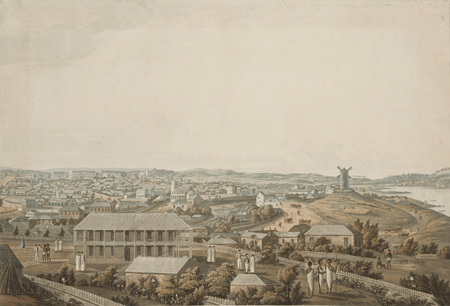
Panoramic view of Port Jackson (1 of 3 sections), about 1821
State Library of New South Wales
It is strictly biographical, in the sense of being focused on one life. Apart from a series of proclamations and a wonderful panoramic view of Sydney in 1821 (from James Taylor's contemporary watercolour), the visitor (as long as s/he enters from the right end) is led from 'Soldier of the King', to 'Governor of NSW', to 'Extending the boundaries', 'Touring the colony', 'Commerce and trade, 'Building the colony', 'Aboriginal relations', 'Education and welfare', 'Elevating the emancipists' (with nothing especially flattering about the 'Exclusives'), 'Opposing the Governor' and, at last, 'Return to Britain'. A display headed 'Macquarie and his family' sits in the centre. In each case there is an audio recording in which a proto-Macquarie (polite male voice, slight Scottish accent) reads from his own writing on the subject at hand.
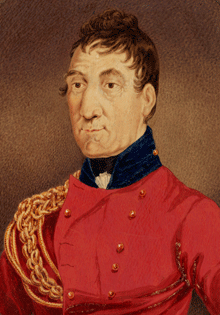
Governor Lachlan Macquarie, 1822
by Richard Read snr
watercolour
State Library of New South Wales
It is an impressive effort, and yet disappointing. The most obvious problem is the meagre attention paid to Macquarie's wife, Elizabeth Henrietta. A display such as this would have been impossible 20 years ago, when curators were almost painfully alert to the need to look for the women, or woman, in the story, and to wrestle with all the problems that went with providing the subaltern, female dimension of their subject matter. Sometimes in the past this was tokenism. In the case of the Macquaries, Elizabeth Henrietta was such an extraordinary figure that to ignore her amounts to perversion of the truth. We are told, under 'Soldier of the King', that Macquarie married twice, and given the names of each wife. But otherwise Elizabeth Macquarie appears only in the display 'Macquarie and his family', where the background arrangement teams her with young Lachlan, her only child. There we are told that she 'took an intelligent interest in architecture and design', that she had 'a genuine concern for the plight of the underprivileged' and that she was interested in the welfare of Aboriginal children. Did she do anything about these things (so we must wonder)? Or did her feelings show themselves only in drawing-room conversation?
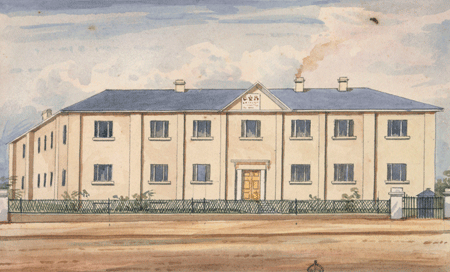
Government House, about 1805
State Library of New South Wales
Among the small number of women who exercised authority at the highest level in colonial Australia, Mrs Macquarie was one of the most complex and dynamic. Her ambition and abilities were on a par with Jane Franklin's in Tasmania, and she was certainly more successful. She is an intriguing character in her own right, and so is her relationship with her husband, who adored her and easily adopted her opinions as his own.
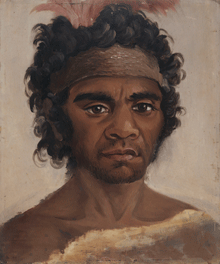
One of the Aboriginal men befriended by Governor Macquarie
State Library of New South Wales
It is not clear, even now, why Elizabeth Macquarie escaped the attention of the early writers of 'women's history' in Australia. No-one asserted her importance, for instance, as they did Elizabeth Macarthur's. (Who was the real founder of the wool industry, Elizabeth or John?) Probably the reason has something to do with the sacrosanct authority of Macquarie himself, as an icon of Australian national identity. The main writers in that genre always treated the story of nationhood with peculiar delicacy.
The somewhat anodyne remarks the State Library display offers about Elizabeth Macquarie may be symptomatic of a wider problem. The treatment of race relations is also unexciting. The displays are visually striking, but they lack intellectual bite. There was a time when museum curators were happy to court controversy, when they aimed to provoke and inspire, when their method of display showed an awareness of new writing and of the ways in which material remains can startle the observer with difficult questions, about human relations and the national story. This is a cheerful display but not a challenging one, and from that point of view it is a lost opportunity.
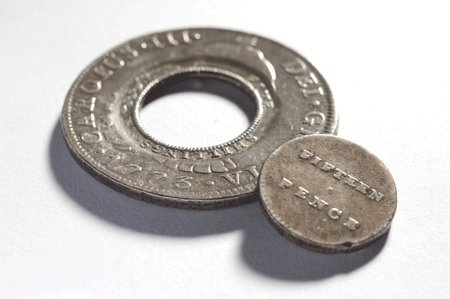
Holey dollar and dump, 1813
State Library of New South Wales
Alan Atkinson is an emeritus professor of history from the University of New England, senior tutor at St Paul's College, Sydney University, and author of The Europeans in Australia.
| Exhibition: |
The Governor: Lachlan Macquarie 1810 to 1821
|
| Institution: | State Library of NSW |
| Curatorial team: | Warick Hirst, Elin Thomas, Jo De Monchaux |
| Exhibition space: | 150 square metres |
| Dates: | 3 Jul 2010 – 10 Oct 2010 |
|
|
|
|
|






